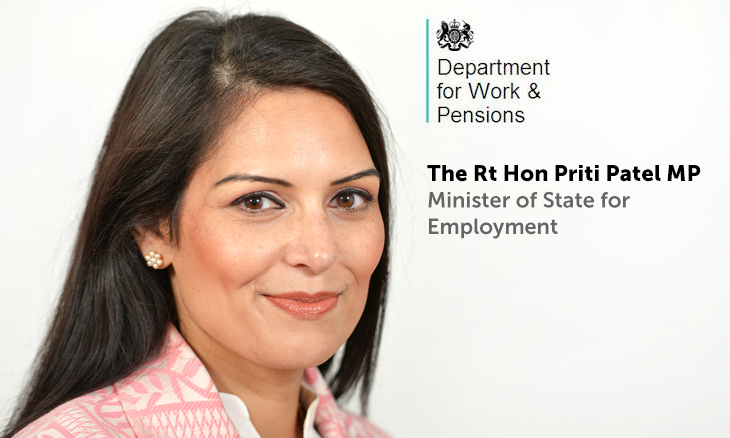 Priti Patel is Britain's Minister of State for Employment
Priti Patel is Britain's Minister of State for EmploymentThe unemployment rate is approaching pre-recession levels, and at 5.3% is the lowest since early 2008. Over the last year, there has been a drop of 210,000 in the number of unemployed people.
Beneath the record-breaking headlines are a number of encouraging figures:
- there are now more women in work than ever before — with an increase of almost a million since 2010
- youth unemployment is at its lowest level since early 2006 — and the employment rate for young people who have left full-time education is up to 74.3%, the highest in more than a decade
- the number of long-term unemployed people has fallen by 25% in the last year to 514,000 — the lowest level in 6 years
Employment Minister Priti Patel said:
“Employment is at a record breaking high, and wages have continued to grow strongly, demonstrating that this government is delivering for hardworking people.
“With 2 million more people in work since 2010, the unemployment rate at its lowest in 7 years, and the number of people on one of the main out of work benefits down by a million since 2010, it is clear that this government is transforming lives for the better, and creating the higher wage, lower welfare society that British people want to see.
“But this growth is only one part of the story, because our one nation approach involves a commitment to provide opportunity and security for everyone across the country.”
Regional growth
The government has committed to narrowing the decades long gap between the north and south by creating a Northern Powerhouse.
This includes investing in skills, infrastructure, science and education to create jobs and opportunities in the north. We are also handing local powers to local people through ground-breaking devolution deals.
Today’s figures show there are 329,000 more people in work in the north of England since 2010.
Other regional success stories include:
- Scotland: the employment rate in Scotland (74.1%) is higher than the UK average of 73.7%
- Wales: the employment rate in Wales rose more than any other UK region over the past year, up 1.7 percentage points – and there are an extra 44,000 people in work
- north-west: there are 75,000 more people are in work in the north-west compared with this time last year – the employment rate is 72.1%, up 1.5 percentage points on the year
- West Midlands: an extra 54,000 people are now in work in the West Midlands compared with this time last year – the employment rate now stands at 71.4%, up 1.6 percentage points compared with last year
- south-west: an extra 84,000 people are now in work in the south-west compared with this time last year – the employment rate now stands at 77.9% – the highest of any UK region, and up 1.6 percentage points compared with last year
Support for hardworking families
Supporting hardworking families by creating a strong economy and moving to a higher-wage, lower-tax and lower welfare society is a key priority of the government.
This includes:
- continuing to reform welfare including lowering the benefit cap to £23,000 in London and £20,000 elsewhere, ensuring that being in work pays
- helping to raise employment by 2 million and create 3 million apprenticeships
- doubling free childcare to 30 hours for working parents
- introducing the new living wage in April which is expected to reach £9 an hour by 2020. This will benefit 6 million workers and boost pay for those on the minimum wage by £5,200 by 2020
The Department for Work and Pensions offers a range of support across the country to help people off benefits and into jobs through the network of over 700 jobcentres.
These include work experience, employer-led training, work placements, skills training, the Work Programme, and help for budding entrepreneurs through the New Enterprise Allowance.
Get The Recruiting Times FREE every Monday – SUBSCRIBE NOW
Recruiters love this COMPLETE set of Accredited Recruitment & HR Training – View Training Brochure








